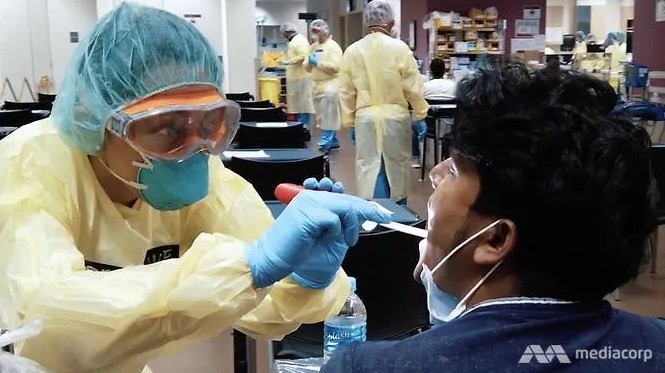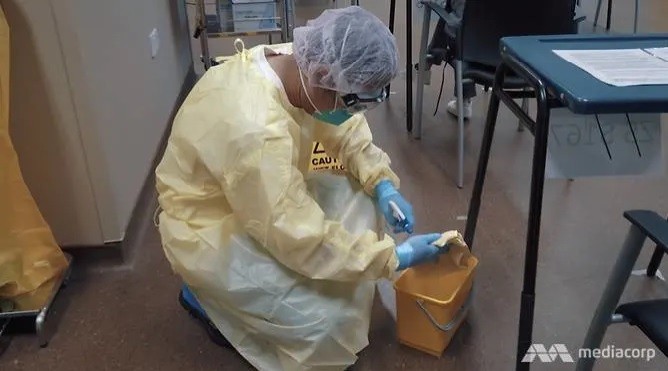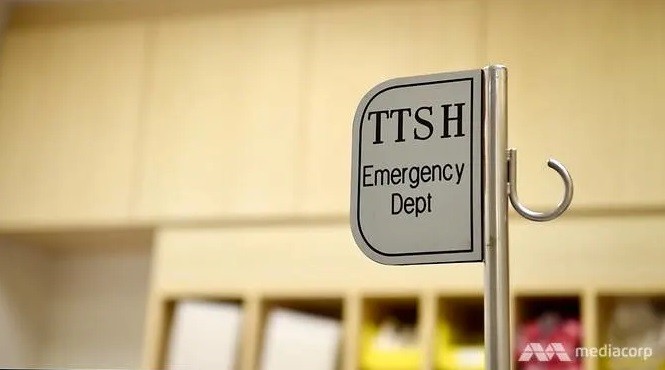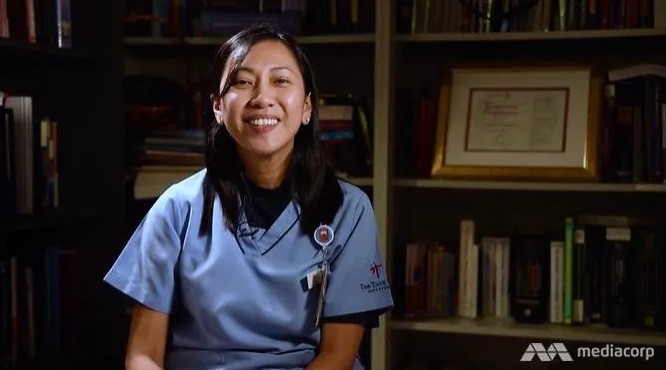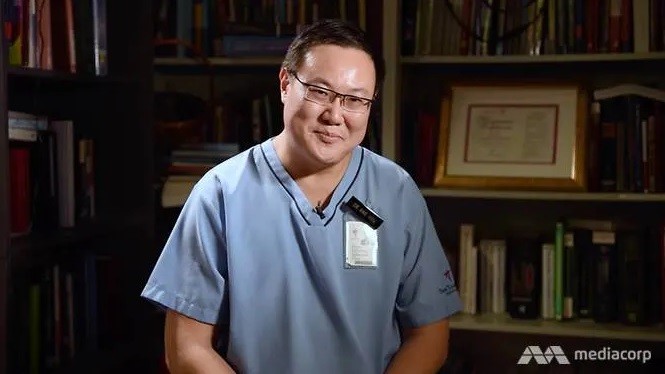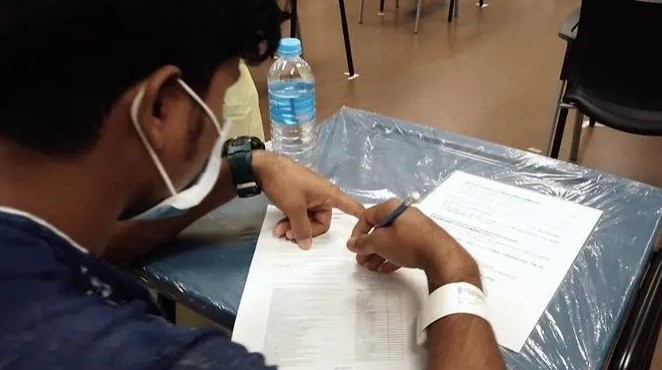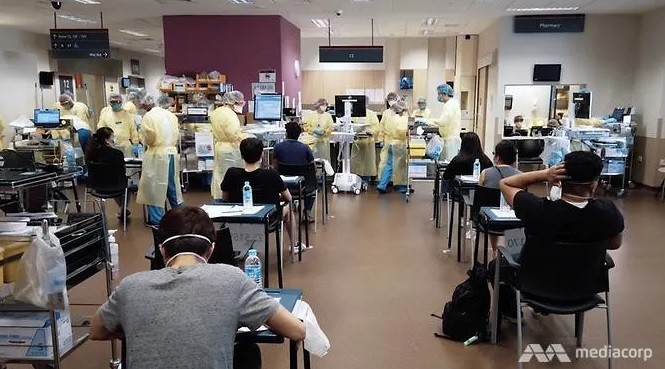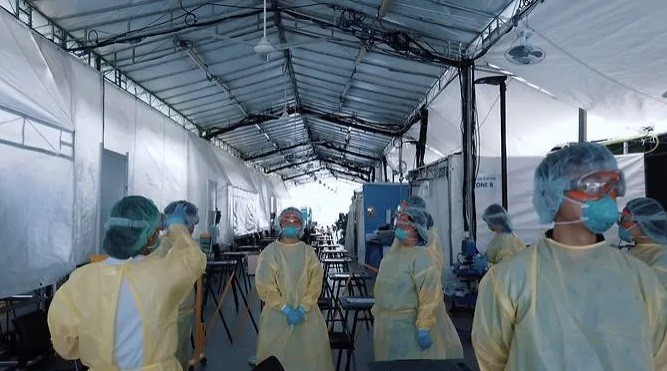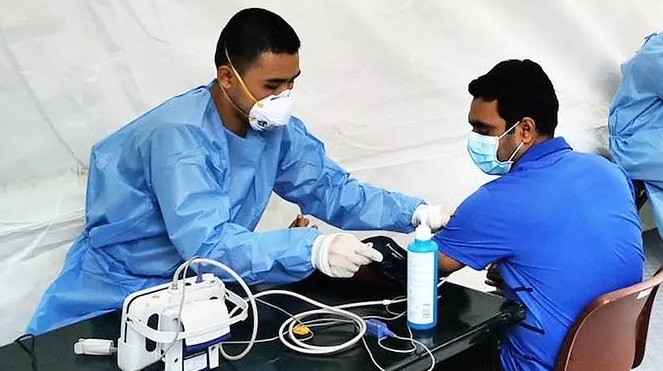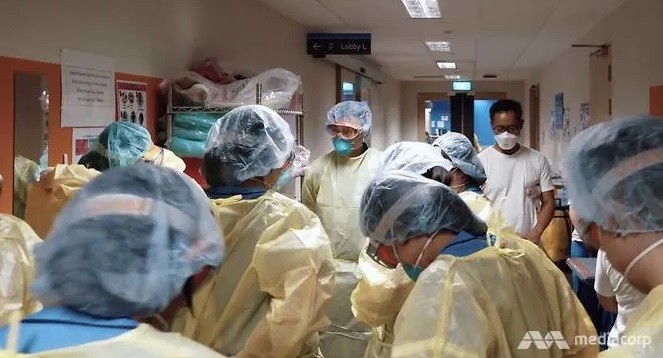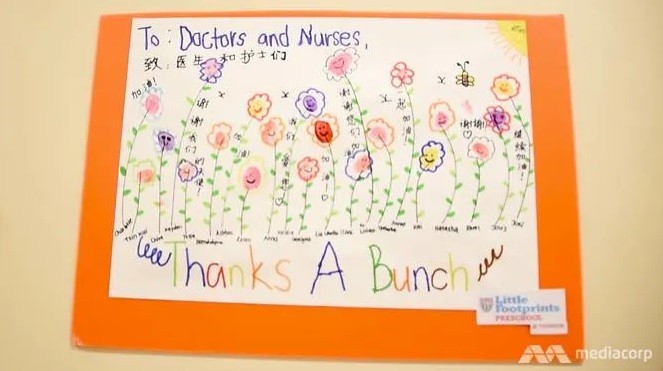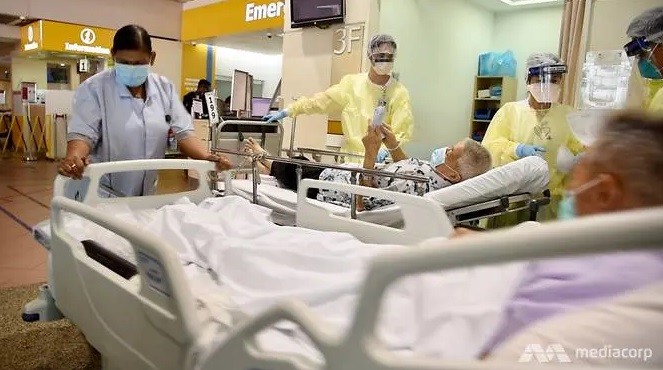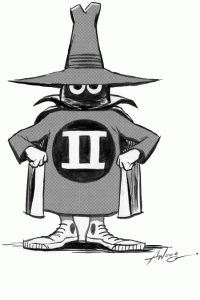Search the Community
Showing results for tags 'Doctors'.
-
dun really know the detail, but to hold protest for weeks and disregard patients need seem very wrong. South Korea to start legal action against doctors over walkout UPDATED MAR 04, 2024, 11:55 AM Doctors chant slogans during a rally to protest against government plans to increase medical school admissions, in Seoul on March 3. PHOTO: REUTERS SEOUL - South Korea’s Health Minister said on March 4 that the authorities will start inspecting hospitals in order to take legal action against trainee doctors who have ignored an ultimatum to end a walkout over government plans to increase medical school admissions. Around 9,000 resident and intern doctors, or about 70 per cent of the country's total, have walked off the job since Feb 20, leading to the cancellation of some surgical procedures and treatments, and straining emergency departments. The government had warned the protesting trainee physicians that they could face administrative and legal penalties, including the suspension of their medical licences and fines, or a jail term if they did not return to work by the end of February. “From today, we plan to conduct on-site inspections to confirm trainee doctors who have not returned, and take action according to the law and principle without exception,” Health Minister Cho Kyoo-hong told a televised briefing. “Please keep in mind that doctors who have not returned may experience serious problems in their personal career path.” For protesting doctors who returned to the field, Mr Choo said the government would consider extenuating circumstances when contemplating any action against them. Later, Vice-Health Minister Park Min-soo told a briefing that the government would take steps to suspend the medical licences of some 7,000 trainee doctors who had left their jobs. Up to now, there has been little sign of either side backing down. Thousands of South Korean doctors held a mass rally on March 3 organised by the Korean Medical Association, which represents private practitioners, defying official calls for the trainee physicians to return to work. The World Medical Association, a group representing physicians, said in a statement on March 3 that it “strongly condemns the actions of the Korean government in attempting to stifle the voices of elected leaders within the Korean Medical Association”, adding that it affirmed the right of doctors to collective action, including strikes. The young doctors who are protesting say the government should first address pay and working conditions before trying to increase the number of physicians. The government says the plan to increase the number of students admitted to medical schools by 2,000 starting in the 2025 academic year is needed in a rapidly ageing society with one of the lowest doctor-to-patient ratios in developed economies – at 2.6 doctors per 1,000 people. The plan to boost medical school admissions is popular with the public, with about 76 per cent of respondents in favour, regardless of political affiliation, a recent Gallup Korea poll found. Some critics, however, accuse President Yoon Suk-yeol's government of not consulting enough and of picking a fight over the issue ahead of parliamentary elections in April. REUTERS
- 41 replies
-
- 4
-

-
- south korea
- doctors
-
(and 1 more)
Tagged with:
-
If you have fifteen minutes to spare. This is quite harrowing to listen. 😥
- 52 replies
-
- 11
-

-

-

-
Did a search and is surprise nobody post this before https://www.todayonline.com/explainer-why-singapore-medical-association-and-private-insurers-locked-battle-over-integrated-shield-plans Explainer: Why the Singapore Medical Association and private insurers are locked in battle over Integrated Shield Plans The Singapore Medical Association (SMA) and Life Insurance Association Singapore (LIA) are at odds over the mechanics of Integrated Shield Plans SMA issued a position statement decrying that the insurers had formed “highly exclusive” medical panels and disrespected fee benchmarks SMA also complained that insurance premiums had increasingly been used for non-healthcare cost items LIA’s comeback alluded to “over-treatment” by medical providers It also criticised SMA for using misleading analysis SINGAPORE — An ongoing tussle between the medical fraternity and insurance companies is intensifying over the payouts, premiums and doctor panels of Integrated Shield Plans (IPs). Such insurance plans are made of two parts: A MediShield Life component managed by the Central Provident Fund Board, and the other is provided by private insurers. About seven in 10 residents here had bought these plans from private insurers to get added coverage on top of MediShield Life, the Government’s basic health insurance plan for all citizens and permanent residents. Last Thursday (March 25), the Singapore Medical Association (SMA) launched an offensive and spelt out in a position statement how IP insurers had been curtailing doctor choice by: This came after weeks of exchanges among insurance policyholders, doctors and the Life Insurance Association Singapore (LIA) on the topic in The Straits Times’ Forum page. SMA also said that insurance premiums collected were “excessively” spent on non-healthcare cost items, pointing out that the growth in insurers’ management expenses (56.6 per cent) and commission for insurance agents (50.4 per cent) had far outstripped that of the medical claims (35.9 per cent). “Instead of repeatedly lamenting that healthcare providers and policyholders are to blame for the losses incurred by some IP insurers through overconsumption, overservicing and overcharging, IP insurers should take the necessary steps to explore cutting their own management and commission costs to enhance the sustainability of the IP sector,” it said. LIA, representing insurers, issued a response to SMA on Monday, saying there were cases of “over-treatment” by medical providers and calling out SMA for using misleading analysis on insurers’ costs and claim costs. On its part, SMA has chosen to take matters into its own hands by introducing an initiative to rank insurers on an annual basis to show the public how appropriate each of the insurers’ fee scales are, and how difficult it is for policyholders to use non-panel doctors. SMA has also set up a complaints committee for patients and doctors to flag issues related to IPs and health insurance, including when patients are being denied insurance coverage or when doctors are not adequately reimbursed for their services.
- 85 replies
-
- 2
-
.png)
-
10, 20 years from now, we want to remember the faces behind the success of defeating COVID-19. No doubt about it, we will win the fight against the virus. Here's a thread out of the many COVID-19 ones, to remember the people behind our success. From Doctors, Nurses, Cleaners, Social Distancing Ambassadors, SPF, SAF, SCDF, NEA, ICA, MFA ... Let's share stories about these angels. Here's one from NCID to start. Inside Singapore’s COVID-19 screening centre, on the front line against the disease As the number of cases continues to rise, it is all hands on deck at Tan Tock Seng Hospital and the National Centre for Infectious Diseases, where doctors, nurses and other healthcare workers screen hundreds of patients daily. SINGAPORE: At the National Centre for Infectious Diseases (NCID) screening centre, one important part of the defence against the pandemic has been none other than ice cream. Charmaine Manauis is hardly joking when she says that. She is the lead consultant in infectious diseases at Tan Tock Seng Hospital’s emergency department, which is in charge of the screening effort. “Ice cream is important; it makes us happy. You see everyone — they have ice cream, they perk up,” the doctor said about her colleagues, and herself. “Plus, it’s hot inside the personal protective equipment. So they love eating ice cream (in the pantry) during their break.” She is certainly not kidding about feeling the heat under their yellow gowns, shower caps, gloves, goggles and N95 masks, which they wear throughout their seven- to 10-hour shifts, except during breaks. “When I remove my yellow gown, I’m usually drenched. It’s really hot,” she said. “When I remove (my mask), then I feel as if I can breathe again.” That is how it has been for the staff running both the TTSH emergency department and the NCID screening centre in the time of the coronavirus. And it is not just emergency doctors who are seeing to the suspected COVID-19 cases. While their department used to have about 20 doctors on shift at any time in the day, it has been a whole new ballgame since Chinese New Year. Hundreds of doctors across different specialities in the hospital — from urology to ENT (ear, nose and throat) to plastic surgery — are being mobilised for training so they can carry out COVID-19 duties too. Since Singapore’s first confirmed case on Jan 23, more than 400 doctors from the hospital have been rostered to work at the NCID screening centre across the road. And the one co-ordinating their training is Manauis, the senior consultant leading the screening efforts — as CNA Insider finds out in an inside look at the frontline battle against COVID-19. GETTING WIND OF THE VIRUS ON HOLIDAY The 42-year-old as well as her boss — Adjunct Assistant Professor Ang Hou, head of the emergency department — were on holiday in December when they first heard of a mysterious disease in Wuhan. “I said, ‘Hm, this might be something.’ So when I came back, the department had already started screening,” recounted Manauis. “We started screening for (travellers from) Wuhan on Jan 2.” That was the day Singapore’s Ministry of Health (MOH) announced that it was monitoring the pneumonia outbreak closely, and sent a circular to medical practitioners here. Whispers of the severe acute respiratory syndrome (SARS) started “floating around” TTSH. “We were SARS central back in 2003, so that’s never left the DNA of the department,” said Ang. “You can’t help but relive memories that you’ve been through, especially when you know your colleagues and your friends had been affected very deeply.” The possibility of a second coming did not surprise him, however. “We were always anticipating something like COVID-19 ... We knew that it wouldn’t be a matter of if, but when,” he said. “We knew that by the time it were to come from Wuhan to Singapore, it would’ve been ... a significant outbreak in the world or at least in this part of the region.” The department started screening for the novel coronavirus (SARS-CoV-2) in a “very small, dedicated space”. But even “way before” Singapore’s Disease Outbreak Response System Condition alert was raised to orange, the number of people coming every day “was growing to a scale that we had to move out of (that) physical space”, he added. As the rest of the country wound down for Chinese New Year, furniture had to be moved in, and computers set up, for the NCID screening centre to be activated. “It was a very busy Chinese New Year for a lot of people, not because we were going around celebrating but because we were preparing for the next phase in screening,” said Ang. By Jan 29, the screening centre was up and running round the clock. FROM SCREENING CENTRE TO TENT Those first few weeks of the centre’s operations were “really hectic” for Manauis. “We were on call 24/7. Every Saturday, we’d train (staff). During the week, we’d look at protocols — we’d look at whether our processes were working well, whether we had to manage any choke points in the screening centre,” she recounted. One of those choke points were the X-ray rooms. “If the screening centre was full, then there’d be a queue for X-rays. And so we’d need more efficiency, more radiographers,” she said. Based on the travel history and the chest X-ray results, the doctors had to decide whether the patients had to be warded or could be discharged. For those who needed admission, those were uncertain times. They had many questions. “How long will I stay? What tests will they be doing for me upstairs? How about my family? Do they need to be admitted too?” cited Manauis. The numbers coming for screening kept rising until the load “became quite difficult at one point”, said Ang. That came about when the MOH changed the definition of a suspect case, following the transmission of the coronavirus at a health products shop visited by Chinese tourists. “That led to a lot of patients being referred by their doctors for screening because they’d come into close and frequent contact with travellers from China,” said Ang. “A lot of people in various industries came in, whether they were taxi drivers, tour bus drivers, people who worked in tourist attractions or hotels, airports and casinos. They were all flooding in.” So, after consulting the ministry, TTSH proceeded to swab and discharge these patients, “to conserve beds for patients who were really ill and needed treatment”. Then there was “a strange point in time”, when the number of people coming for screening and the cases confirmed as positive slowed down, even as the numbers were picking up in the rest of the world. “We knew that the numbers would go up sooner or later,” said Ang. “We knew that the screening centre might not be able to cope ... so we made the decision together with the ministry to set up a tentage, to expand the number of places available.” That ended up being the case. On March 23, the TTSH team screened the highest number of people until now: More than 520. “We call it the most terrible Monday,” said Manauis. “The patients came in the afternoon and at night. And at night, we have less manpower. We had to open the tentage until 3am, with a lot of patients having to wait a little bit longer. So that was a struggle.” MIGRANT WORKERS A NEW CHALLENGE There are still hundreds of patients screened daily, although the challenge as of late is not the numbers but the space needed, as the spike has been among migrant workers, and the tent outside the screening centre is “perennially full”. “For these foreign workers, we need to wait for swab results before they can be discharged (if they test negative). So we need a bigger waiting area for them,” said Manauis. “After that, they have to wait for transport also, to bring them back to their dorms. So they can wait for as long as, probably, 18 (to) 20 hours.” WATCH: An exclusive look inside the NCID screening centre (Dur 5:20) While there are now Swab Isolation Facilities like the CherryLoft chalets — where the workers can be sent after their nose swabs — these facilities “are quite full” nowadays, she added. The workers are otherwise unable to self-isolate. "Every day, we’d have to ask whether there’s any vacancy, and then they still need to wait for an ambulance or dedicated transport." While there is swabbing done at the dormitories now, some of the workers need to go to the screening centre depending on their symptoms. If they complain of chest pain or have difficulty breathing, for example, then they need an X-ray, a blood test or an electrocardiogram. As long as they are symptomatic or have had close contact with a positive case of COVID-19, they should be swabbed. An MOH circular sent on Thursday has also updated the swabbing criteria for everyone. Anosmia — the loss of the sense of smell, either total or partial — is now one of the symptoms to look out for, cited Manauis. “There were (research) papers that came out, and there were positive cases which presented only with anosmia,” she explained. The other symptoms still include fever, runny nose, cough, sore throat and gastrointestinal symptoms like diarrhoea or vomiting. Since she started on TTSH’s clinical protocols and work instructions for COVID-19 screening and infection controls, Manauis has developed 61 versions for the staff to follow. There is also a workflow for the foreign workers from dormitories, which is at version 17 now. IN FOR THE LONG HAUL She has also trained nine batches of doctors from various departments, with as many as 51 physicians in a batch. They work a 10-day cycle as part of a group of more than 100 people, including nurses and other healthcare workers, running the screening centre. Most of them, even senior specialists, are volunteers, and some have done more than one rotation, although each department is also supposed to contribute a certain amount of manpower. “Screening is very different from what they do every day. So it wasn’t a surprise that they were a little bit apprehensive. But they were very willing to help out,” said Manauis. She is grateful for all the support. At one of the training sessions this month, she told the doctors: “We really need your help on the front line. On behalf of the emergency department, I thank you guys for volunteering.” The thing is, her department is not only working at the screening centre, but also attending to the usual emergency cases. To do this, the staff have cancelled their leave and reduced their days off. “You just have to do your work. I go day by day — whatever needs to be done, needs to be done,” she said with a shrug. “Everyone’s made sacrifices, not only me or not only the doctors ... But we do this willingly because we know that this is our job.” The emergency cases are tended to in a different zone, although that does not mean the staff necessarily get to dispense with personal protective equipment. The forward screening triage nurses, for example, must wear the full equipment. “Sometimes walk-in patients ... are close contacts (of a COVID-19 case), so we have to protect our frontline staff,” said Manauis. To protect the patients as well, one of the changes made is to ensure that they queue at least two metres apart. This, and many of the current arrangements in the emergency department, could be in place for some time. “For those of us who’ve been here for a while, who’ve gone through other outbreaks, we know that, potentially, it’s going to be long-drawn,” said Ang. “It could affect some of our own members — that the memories of SARS come back — and I think it might hit those (employees) a little bit harder.” When asked on Friday about her team’s morale, Manauis, who has been with TTSH for 15 years, gave a cheerful reply. “We’ll try our best to ... help the nation, especially now that (the number) of positive cases has been increasing,” she said. “We’re still okay. We still have ice cream, so we’re happy. I mean, you’ll need to try and pace yourself because we know that this is going to stay for a few more months.” https://www.channelnewsasia.com/news/cnainsider/inside-singapore-covid-19-screening-centre-defence-disease-ncid-12656312?cid=fbcna&fbclid=IwAR2aRtq_Z2MAo0V4ZhWSMMaT9GnvC_-dupS3ZWBKls8QOzPkW7931n7Pa0M
- 105 replies
-
- 12
-

-
- healthcare
- doctors
- (and 7 more)
-
Urban legend or dream come true? Former journalist and bank employee training to be doctors https://www.tnp.sg/news/singapore/former-journalist-and-bank-employee-training-be-doctors Ex-VP of bank and former journalist among this year's intake of future clinicians at Duke-NUS Medical School. One worked in a bank. Another was a former journalist. And now, they are studying to be doctors. They are two of the 81 students in this year's intake of future clinicians at Duke-NUS Medical School, Singapore's only graduate medical school. Mr Lim Chun Chai, 39, a father of two, was a vice-president at OCBC Bank for nine years. He was responsible for processing and documenting corporate loans. Ms Hoe Pei Shan, 31, is a former journalist at The New Paper, The Straits Times and The Business Times. If they complete their four-year graduate programme, they will be awarded a medical degree in 2023. Before enrolling at Duke-NUS, both Mr Lim and Ms Hoe took the Medical College Admission Test administered by the Association of American Medical Colleges.
- 39 replies
-
- 7
-

-
- journalist
- bank
- (and 6 more)
-
Ok guys, I know there are some docs in this forum so I need some advice. I have a old back issue which gives me leg pain. So I went to see a specialist in Jan this year in a public hospital. I asked the doc to see if it could be peripheral arterial issue and he said is very unlikely but an ultrasound will clear it up. He set up an ultrasound in Feb and followup appt in April. So i went for the ultrasound and the guy doing it verbally said everything looks ok and I will get my report through the doctor. Fast forward to April, my back is improving so I decided to cancel the followup appt and just want my ultrasound results. I called hospital and they refused to release the scan result (which I paid for) to me without me fixing an appt with the doctor. First thing I found out was, no doctor annotated on the results for over two months.... so if the scan showed something wrong, I bet treatment will be delayed for 2 months. Is this legal? Can't I change doctor and obtain the scan result and see my own doctor outside? Is there anything I can do to convince them to give me my scan results without setting up another appt.
-
I am thinking with all these legislations, medical displinary councils, and all the money spent, won’t it be more efficient to create a body to track the outcomes of the patients of various Doctors? It is a step towards a value based healthcare where pay is linked directly to patient outcome but that is hard to do. One of the problems is that patients does not know who are the good Doctors. The government can set up an independent body to survey patients and track outcomes. Apply a consistent metric and make the information publicly available. It’s like word of mouth but regulated and much more reliable. It is also safer for Doctors as your practise is unlikely to be destroyed by one bad patient assuming u have lots of glowing reviews from other patients. Of course u have to start thinking about whether your patient will be happy after the treatment as now there is a stronger impact...
-
.........for illegally using SGH’s computer system to sort out personal affairs https://www.todayonline.com/singapore/plastic-surgeon-suspended-3-months-illegally-using-sghs-computer-system-sort-out-personal?fbclid=IwAR3QqrrqoTQ4jRWFbPFPL1_EyaDSTMVKnjk_vXg1EbV3RFETaaJVxXVvexo SINGAPORE — Suspecting his wife of having an affair, a plastic surgeon accessed the computer system of the Singapore General Hospital (SGH) to get contact details of the wife of her alleged lover, in the hope of saving his own marriage. Dr Leo Kah Woon also installed a keylogging software on the laptop he shared with his wife to spy on her personal communications. He later used the information he got in their divorce proceedings. For his actions, a disciplinary tribunal of the Singapore Medical Council (SMC) suspended him from practising for three months from Dec 18 last year. In its grounds of decision published on Tuesday (March 5), the tribunal noted that a suspension "would well deter like-minded medical and other professionals who have access to large databases of personal information from abusing the privilege”. In particular, last year’s SingHealth data leak served as a “timely reminder” for everyone to treat cyber security with “the utmost seriousness”, the tribunal added. Read also S$50,000 fine for psychiatrist who failed to protect patient’s confidential info Dr Leo, who has since divorced his wife, now practises at his own clinic at Mount Elizabeth Medical Centre. He was employed at SGH when he committed the offences. In 2017, he was fined S$13,000 in the court for his actions. The SMC then began disciplinary proceedings against him, as his offences implied a character defect making him unfit for the medical profession. THE SPYING BEGAN Dr Leo and his wife tied the knot in 2005. However, sometime in 2011, he started suspecting that she was cheating on him. Her alleged lover was identified in SMC’s grounds of decision merely as Mr C. Around September 2012, he installed a keylogging software in the MacBook Pro laptop he shared with his wife. The software captured her keystrokes and took periodic screenshots when she used the computer, which were sent to his email account. This meant that he could gather information about emails and instant messages that she sent. The spying continued when she left their home to live with her parents and took the laptop with her. The tribunal noted that in October 2012, she began “very acrimonious” divorce proceedings against Dr Leo after he asked her to leave their home. The pair, who have two children, finalised their divorce in May 2015. During their divorce proceedings in the Family Justice Courts, Dr Leo used the information he gathered to explain his concerns about issues relating to the custody, care and control of their children. He also wanted to find out all he could about Mr C’s wife at the time, identified as Ms A, and reach out to her. Dr Leo hoped that Ms A would be able to convince her husband to leave his family alone. On Nov 7, 2012, when Dr Leo could not find any reliable public information to contact Ms A, he used a computer at SGH to search for her contact details in the hospital computer system. He then gave the details to his sister and told her to call Ms A. Ms A came to know of her husband’s infidelity from that call. Mr C then filed a complaint with the SMC against Dr Leo and the police were called in to investigate when the illegally obtained emails and messages were used in the divorce proceedings. Dr Leo’s wife was fined S$3,500 by the courts, for abetting a private investigator to unlawfully access his Asus laptop on Dec 18, 2012. She had seen documents related to the divorce proceedings on it and wanted to make copies of them. A LACK OF INTEGRITY The SMC sought a suspension of at least six to eight months for Dr Leo, while his lawyers asked for a S$10,000 fine. While the SMC argued that Dr Leo had displayed dishonesty, which could see him being struck off the registry of medical practitioners, the disciplinary tribunal concluded that there was no clear evidence of that in his conduct. Instead, it said that he clearly displayed a lack of integrity “to a somewhat appalling extent”. Dr Leo had hired a private investigator to surveil his wife, including installing the keylogging software on the laptop to gather evidence against her in the event of divorce proceedings. To use this evidence “brings (his) integrity to the lowest of levels”, the tribunal added. As members of the public expect doctors to keep medical records confidential, a fine would not be enough to correct his breach of trust, it said. “A suspension would also convey to the public that the disciplinary tribunal does not condone such behaviour and acts, even if they are related to matters in the private family domain. It will convey the message clearly that doctors are expected to conduct themselves with integrity and ethically both in their professional and private lives,” the tribunal added. Dr Leo was also censured, as well as ordered to give a written undertaking to the SMC not to engage in similar conduct and to pay the costs of the disciplinary proceedings. i smell a rat...seems like all sorts bad news abt doctors of late.....sth brewing??? then Gan KY talks abt increases in healthcare costs...hmmm
-
Susan Lim sells home at Sentosa Cove for $39mil 2 March 2012 Straits Times EMBATTLED surgeon Susan Lim has sold her sea-facing bungalow in Sentosa Cove for $39 million, a record absolute price for the upmarket enclave. It is believed the home - a plush residence said to have five bedrooms and an entertainment room - was bought by an Indian national from the energy sector. A few months ago, his purchase would have attracted the standard 3 per cent stamp duty, but the measures that came in on Dec 8 imposed an additional 10 per cent duty on foreign home buyers. So the buyer will now have to stump up about $5 million in levies for the privilege of buying Dr Lim's home. Sentosa Cove is the only place where non-permanent resident foreigners can buy landed homes, although transactions still need government approval. Dr Lim's 15,929 sq ft estate in Cove Drive - likely two adjoining plots that had been merged - was priced at $2,448 per sq ft (psf). That is well above auction prices achieved for 12 vacant Sentosa Cove bungalow plots in the southern precinct where Cove Drive is located. Each plot went for between $656 and $1,039 psf in August 2006, or between $5.56 million and $8.15 million each. They do not include the construction costs. But even taking into account these costs, Dr Lim most likely has made a handsome profit from the sale. The Lim sale smashes the old record of $36 million - or $2,403 psf - paid for a 14,983 sq ft bungalow on Paradise Island in the northern part of Sentosa Cove. Mr Shen Bin, a Chinese national and Singapore permanent resident, is believed to have bought the property in May 2010. Mr Shen is said to be the son of billionaire entrepreneur Shen Wenrong, chairman of China-based steel manufacturer Shagang Group. The island experienced tepid sales volumes last year, so this latest mega-deal could revive the sector. Only 79 caveats - 24 for landed and 55 for non-landed homes - with a total value of $737.6 million were lodged with the Urban Redevelopment Authority last year. And there were only 12 new home sales last year, forcing some developers to look towards renting out completed but unsold projects. The lacklustre 2011 followed a better year when 203 caveats - 62 landed and 141 non-landed homes - with a value of $1.7 billion were lodged. With 75 caveats lodged, 2008 was the only year with lower sales volumes than 2011 since caveats started being lodged for Sentosa Cove in 2004. Dr Lim was in the limelight after she took the Singapore Medical Council (SMC), which regulates the medical profession, to court. She had wanted to block an inquiry by a second medical disciplinary committee to look into complaints of overcharging. There were allegations that she charged a member of the Brunei royal family $24.8 million for seven months of treatment and made false representations in invoices rendered to her. The patient died of cancer in 2007. Dr Lim later gave a 50 per cent discount. After losing her case in both the High Court and the Court of Appeal, she has to bear the cost of her own legal fees as well as those of the SMC. In such civil suits the losing party has to pay a part of the winning party's legal charges. This is in addition to the fees Dr Lim has to pay her own lawyers. She will also have to pay costs for both hearings.
-
Interesting piece. Where is our resident MCF doc Lala81 to comment? Alas there are black sheeps in every profession... From ST Forum: http://www.straitstimes.com/STForum/Online...ory_811310.html Doctors, don't lose your principles Published on Jun 16, 2012 THE medical profession has become, for some doctors, the means to amass great wealth. Two encounters I had with doctors left me disgusted. Some years ago, I took my son to a specialist for a procedure. After I paid the bill, the specialist chided me for not telling him that my son was covered by my company's medical insurance scheme. His exact words: 'Had I known that you were covered by insurance, I would have charged you twice the amount.' Recently, I consulted a specialist on a medical condition. I paid for the consultation, blood test, medication and a series of three treatments, which were to follow. At one of the treatments, the specialist happened to enter the treatment room while I was being attended to by a nurse. We engaged in some small talk, which inevitably drifted to a conversation on my condition. At the end of the treatment, I was billed $96.30, including goods and services tax, for the 'consultation'. On querying the nurse, I was told that as long as I spoke with the specialist, a consultation charge would be incurred. I found this baffling as my visit to the clinic was for treatment, and I did not have an appointment with the specialist. Nevertheless, I paid. It has become increasingly hard to find doctors who are true to their calling - dedicated, professional, compassionate and humble. Lawrence Loh
-
are we patients'getting tight a s s or are doctors getting dangerous who is this Dr. Chan Mui Yoke anyone got a picture of her and expert bro with CSI skills understand this is a PRC family Leukaemia boy's death: KKH settles suit 2 June 2011 Straits Times THE parents of a 14-year-old leukaemia victim and the KK Women's & Children's Hospital (KKH) have settled an alleged-negligence suit out of court. The terms of the settlement are confidential, but the parents of the late Cao Yuanchi had sought $1.8 million in damages in the statement of claims supporting their suit; this included the loss of whatever money their son, a Raffles Institution scholarship student, would have have given them from his eventual earnings to support them in their old age. The defendants, the hospital and Dr Chan Mui Yoke, had asked the High Court last month to assess the compensation payable to the boys' parents, on condition that the hospital and the doctor are not found liable for Yuanchi's death. But the parents, Mr Cao Shengfa and Madam Ma Wenying, objected to the application, describing it as a 'complete farce' in court documents filed. Assistant Registrar Ang Ching Pin then threw out the application, which sent the two parties into private negotiations. Lawyers said there have been medical negligence cases in which the medical defendants were allowed to settle for damages to be assessed without admission of liability on their part - but it was possible because the suing party consented to it. Dr Chan had sought to appeal against the Assistant Registrar's decision, but withdrew the move last week after both parties resolved the matter. Yuanchi died five days after being admitted into KKH in January 2009 with bruises on his right leg, rashes and fever. The diagnosis, that he had a rare form of blood cancer known as acute promyeloctic leukaemia (APL), came two days later. A course of chemotherapy and a treatment using all-trans retinoic acid (Atra) were lined up for him. But the treatment, discussed with his parents on Jan 15 along with the diagnosis, could not start immediately, as the boy was also battling a bacterial infection and the treatment for his leukaemia had to be pushed back. Yuanchi's parents were told he faced a high risk of bleeding because of the APL. The boy never got started on chemotherapy on Jan 19 as scheduled. He died the day before from massive bleeding in the brain caused by the leukaemia. His parents claimed they were not informed of the risks tied to withholding treatment for APL for the four days while their son was treated for the bacterial infection. The hospital said through its lawyer Kuah Boon Theng that Dr Chan had taken into account the risk factors associated with the treatment when setting up the treatment plan. Lawyer Lee Mong Jen, representing Yuanchi's parents, declined comment. A hospital spokesman also declined comment on the grounds that 'the matter has been settled with a view to the suit being discontinued in due course'.
-
Post this to understand more . . . hope it has not been posted yet. Doctor's captions on YouTube videos of spat spark harassment case http://www.straitstimes.com/news/singapore/courts-crime/story/doctors-captions-youtube-videos-spat-spark-harassment-case-2015011 What began as a petrol station spat between two men has escalated into an anti-harassment case involving YouTube videos. A district court yesterday ordered Dr K. Paramesvaran, who is better known as Dr Param, to remove the captions he had put into two videos that he uploaded detailing his run-in with Frenchman Yannick Pierre Yves Le Borgne at a Caltex station last April. The order is an interim one until the case is settled in court. This is believed to be the first time thaoot a court has issued an expedited protection order (EPO) under the Protection from Harassment Act, landmark legislation passed last year which, among other things, seeks to curb online harassment. Unlike a protection order, an EPO is issued on a temporary basis to prevent further alleged harassment until a case is settled. The court has also ordered that the captions cannot be printed by any other parties. The videos seem to have been taken from closed-circuit television footage at a petrol station in the Holland Road area. In one 6.5-minute video, Dr Param, managing director of Medical Imaging, which runs a chain of radiological clinics, is seen paying at the petrol kiosk's counter. A Caucasian man then approaches the doctor from behind, and starts talking to him. He points his finger several times, and is also seen patting Dr Param on the shoulder. In another three-minute video, the 36-year-old Frenchman is seen stopping his car alongside that of Dr Param's as he is pumping air into his tyres. He steps out of the car and again gesticulates towards Dr Param and engages him in some kind of argument. It is unclear what started the spat but the entire episode seems to have left Dr Param aggrieved. He lodged a Magistrate's Complaint shortly after the incident and the case was probed by the police as a case of intentional harassment. But last November, police informed him that after considering the facts and circumstances of the case and with advice from the Attorney-General's Chambers, no further action would be taken against Mr Yannick. Last month, the doctor, who is in his 60s, posted the two videos to air his grievances. Mr Yannick, who is represented by lawyer Choo Zheng Xi, claimed the text and commentary accompanying the videos, which could have gone viral, was a continuing source of harassment to him. He applied to have the text removed. The judge ruled that the videos have to be renamed "Incident at Caltex on 20 April 2014". But Dr Param, who was defended by lawyer Foo Soon Yien, is free to state on the videos that the previous comments had been removed pending a trial. According to the ruling, failure to obey the court's order could result in a contempt of court action or a Protection of Harassment Act offence which carries a fine of up to $5,000 and/or a jail term of up to six months. Responding to queries, a State Courts spokesman said yesterday that since the new Act came into force last Nov 15 till Jan 7 this year, there have been 79 Magistrate's Complaints for harassment. There were also 13 applications for Protection Orders under Originating Summons. Magistrate's Complaints relate to criminal cases while Originating Summons are civil remedies. Three Protection Orders have been issued by the State Courts, and the remainder of the cases are ongoing, she added.
-
Useful article forwarded by Liak Teng Lit, CEO of Khoo Teck Puat Hospital. Very often, when an elderly loved one suffers a medical crisis, we call the ambulance. At the hospital, we ask what can be done to save the person. We don
-
Our resident doc bro lala81, comments? From ST Forum: http://www.straitstimes.com/STForum/Story/...ory_815761.html Doctors leave public sector for reasons other than money Published on Jun 28, 2012 DR GERARD Chee's most obvious conclusion from the report ('Private versus public hospitals: More than twice as costly'; last Friday) was 'how poorly paid public hospital doctors are', as reflected in the lower cost of public health care ('Bill comparisons may not reflect true cost differences'; Tuesday). This seems inappropriate. To put things into perspective:
-
Lasik eye surgeon charged with cheating healthcare provider By Alvina Soh | Posted: 25 November 2011 1448 hrs SINGAPORE: An eye surgeon was charged on Friday with cheating a healthcare provider of more than S$474,000. Fifty-one-year-old Marc Tay Tze-Hsin allegedly cheated integrated healthcare provider, Pacific Healthcare Specialist Services (PBSS), on 11 occasions between December 2005 and December 2006. He is said to have dishonestly concealed the fact that he had been paid between S$2,520 and S$83,000 for each surgery he performed at The Lasik Surgery Clinic on behalf of PBSS knowing the amount belonged to PBSS. He will be back in court again on January 6 next year. It boils down to the fact that even doctors are human. and which human doesn't have needs, wants and desires. if they dun have, they are not human. Saving lives, yes, otherwise why would they want to become doctors? but basic human characteristics do not change.
-
Hi Doc, Need to find out more... Recently i am having hip pain, in particular dull on & off pain is felt at the front "ball & socket" joints (between thigh & abdomen). Most pain felt at left side joint when I lie down or sit. Walking still ok. But I did not fall or get into any accident. I'm afraid there is something wrong going on like dislocation or some hip condition which I saw on the internet. Not sure the cause of pain. Maybe my lumbar got injured thus causing the pain to radiate to the hip? Possible? Of course i will go see a doctor soon but wonder if i should see a GP or hospital or even a chiropractor? Can an orthopaedic doctor provide some answers? Thanks...
- 18 replies
-
- Orthopaedic
- doctors
-
(and 3 more)
Tagged with:



